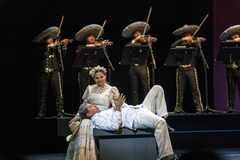| Opera Reviews | 27 April 2024 |
A tale of migration and metamorphosisby Arlene Judith Klotzko |
|
Martinez: Cruzar la Cara de la Luna |
|
|
The production which premiered at Houston Grand Opera in 2010, is based on a book by Leonard Foglia who also directs. The set is minimal but the lighting by Gary Echelmeyer is marvelously evocative, particularly the huge, hot sun burning in the orange sky. The music by Jose “Pepe” Martinez conveys so many moods. The thirteen members of the two-time Grammy award winning ensemble, Mariachi Los Camperos, are simply wonderful. The choreography by Keturah Stickann is just right for its context and the characters. The beautiful Rose Theater at Lincoln Center again hosts the New York City Opera. The performance opens with a ballad evoking the great migration of the monarch butterflies, establishing this as a metaphor for the cycle of life. The image of the monarch migration is used to evoke both the fragility and uncertainty of an individual life, and the power of love and family to find a home, and to continue beyond the individual. Given the current debates about immigration in the United States, Cruzar la Cara de la Luna seems especially timely. The central tragedy here is that of a young family shattered by economic stress. When Laurentino goes to work in the United States trying to build a better life for his family, his wife, Renata, sung by Cecilia Duarte, only wants the family to be together. She tells a friend that she did not marry in order to get money in the mail. Pregnant and desperate for her child to be born in America and thus be considered an American, she dies on the journey as her young son, Raphael, looks on helplessly. This plot point surely has especially strong resonance here in New York, which has been declared a sanctuary city in order to protect its considerable population of undocumented immigrants from deportation. The audience was attentive and enthusiastic. Clearly some identified with the experiences of the characters on stage; there were many audible sighs and even sobbing. The story is told through the eyes of Laurentino, sung by Octavio Moreno, who looks back on his youth in Mexico as he nears the end of his life. His son from his second marriage, Mark, sits near his gravely ill father playing the guitar and singing a song about a dying caterpillar who will be transformed into a butterfly. We see Laurentino in the first scene and then in the last, in a hospital bed on the virtually bare stage. Moreno’s strong baritone conveys the energy and optimism of youth in the flashback scenes, switching easily into a desperate longing as the dying man yearns for his first son and Renata, the wife he lost long ago. Also in the flashback scenes, Vanessa Alonzo brings a plangent sweetness to the role of Lupita. Just like the migrating butterflies in Mark’s song, future generations find their way home. Through the efforts of Mark, sung by Efraín Solís, and Mark’s daughter Diana, sung by Maria Valdes, the long lost first son Rafael, sung by the superb tenor, Daniel Montenegro, is located. Laurentino dies surrounded by both his families, including his granddaughter Renata. Cecilia Duarte is the heart of the opera and the symbol of love, family and even rebirth as she also plays the role of Renata’s granddaughter. She is superb – singing with a rich beautiful voice and dancing with a combination of grace and abandon; As the family return his remains to Mexico, the survivors realize in a lovely quartet that family, not country, is the true meaning of home. This is the musical climax of the piece, with strong singing and perfect blending from Solís, Valdes, Montenegro, and Duarte. And of course they are surrounded by butterflies.
|
|
| Text ©
Arlene Judith Klotzko Photos © Sarah Shatz |

 Although billed as the world’s first mariachi opera, Cruzar la Cara de la Luna is more like a piece of musical theater in its current production by the New York City Opera. Its plot and character development are largely driven by spoken dialogue (which alternates between English and Spanish as do the supertitles but in reverse). The music, supported by an ebullient and energetic mariachi band, serves largely to reinforce the broader themes of the work. Amplification also makes the work seem rather unoperatic.
Although billed as the world’s first mariachi opera, Cruzar la Cara de la Luna is more like a piece of musical theater in its current production by the New York City Opera. Its plot and character development are largely driven by spoken dialogue (which alternates between English and Spanish as do the supertitles but in reverse). The music, supported by an ebullient and energetic mariachi band, serves largely to reinforce the broader themes of the work. Amplification also makes the work seem rather unoperatic. 





